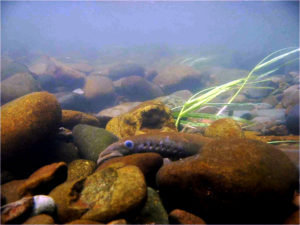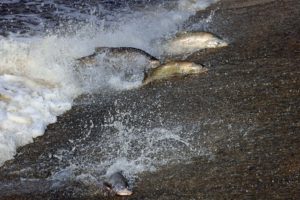With last year’s wet winter and this fall’s early rains in October, time is short for the staff and volunteers of the Salmon Protection and Restoration Network (SPAWN), who are working hard on several projects aimed at helping the Lagunitas Creek run of coho salmon — the largest remaining wild coho run in the state.
The urgency stems partly from bureaucratic matters, says SPAWN biologist Carrie Sendak. Grants funded by the California Department of Fish and Game need to be completed before the money runs out and the heavy rains of winter arrive.
But then there’s an urgency brought by the salmon themselves: When the creeks are flowing stronger, salmon are most able to detect the distinctive scent of their home streams. With the rains come rushing streams, and with the high waters come coho.
How long that equation will hold may be partly a question of the work SPAWN is doing right now. The Lagunitas watershed in West Marin near San Geronimo and Woodacre has had one of the most active coho runs of any California creek for the last decade and more. But over time the creek’s run, along with coho populations throughout the region, have dropped to dangerously low numbers.
There have been decades of harsh treatment: Logging that dumped sediment into streams, dams that blocked passage, water diversion that reduced flows–all have strained the condition of the creeks.
Today, says Sendak, bank restoration is key. SPAWN staff and volunteers can’t wave a magic wand and make the salmon population reappear, but they can give them an optimal place to return to. Along stretches of private property and public land on San Geronimo Creek, SPAWN is implementing several stabilization projects with the help of volunteers and private contractors.
“This is a superb opportunity for the public to get involved with helping the salmon,” says Sendak. “They will be hands on with state of the art restoration techniques and the work is a lot of fun and very satisfying.”
Tactics such as willow walls, willow brush mats, and native plant revegetation help stabilize the banks, preventing erosion and keeping the water clear. Coho streams also need to be cool: Anything above 70 degrees is too warm. In order for these conditions to be met the banks need to be well vegetated to create shade and filter the toxins from ground run-off. Placing woody debris and boulders in the streambed creates refuge for adolescent coho to spend the first year of their lives. It is in these nooks that food for the young salmon also thrive: insect larvae and opossum shrimp to name two.
Eventually, some of those young fish make it to the ocean and, with nay luck, return three years later to spawn. But the salmon face constant struggles. Aside from damns, logging, and historic overfishing, building along streams can cause increased sedimentation and runoff in streams, streams can be polluted with pesticides and excess nitrogen, and even those fish that make it to the sea have recently faced reduced ocean productivity, possibly due to climate change or other ocean cycles.
“All of these factors are continuing to play a role in the coho’s decline in this watershed and salmon populations throughout the West Coast,” says Sendak. “A big focus of SPAWN is to work on areas we have more control over, which is riparian and creek bank restoration and protection to help the coho have the best spawning grounds available in the Lagunitas Creek Watershed.”
SPAWN is hosting volunteer days every Saturday on the Lagunitas Creek from 10 a.m. to 2 p.m. They also offer free consultation of bank stability on your own property. Come winter, they’ll be holding naturalist-led salmon-spotting walks every weekend as well. For more information visit spawnusa.org.
For an articulate and detailed look at this watershed and its salmon, check out this Bay Nature feature by Jules Evens.

.jpg)



